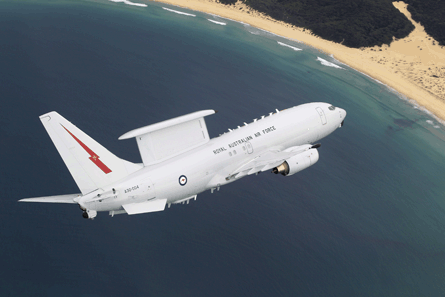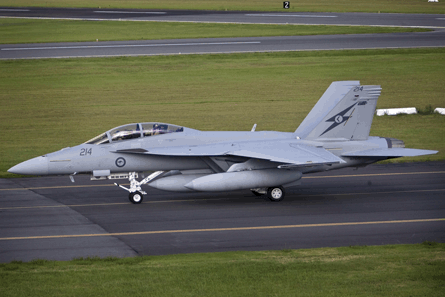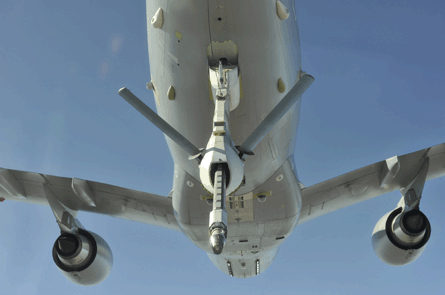Visitors to this year's Avalon air show will bear witness to the radical changes planned for Australian air power.
With the retirement of the last General Dynamics F-111 in December 2010, there will be no burning fuel dumps. Instead, the show will be all about advanced capabilities, with appearances by the US Air Force Lockheed Martin F-22 Raptor and Northrop Grumman B-2 Spirit. While neither of these stealth types will ever be part of the Royal Australian Air Force, their presence highlights the evolution of air power in Asia Pacific - and provides a prelude to the RAAF's eventual adoption of the fifth-generation Lockheed F-35 Lightning II.
"Australia has big military aviation challenges," says Teal Group analyst Richard Aboulafia. "They need to reconcile budget constraints, the need to procure the best systems to do particular jobs, and the logistical and training constraints of the country's strategic relationships. In other words, they need to procure the optimised systems for intercept, coalition war fighting, surveillance, maritime patrol and transport."
 |
|---|
© Australian DoDFour Boeing 737 Wedgetail early warning and control aircraft have been delivered to Australia in an initial configuration |
Some sense of the challenges facing the RAAF as it modernises can be gleaned from the Department of Defence's Projects of Concern list, where one can find virtually every current military aircraft acquisition programme in Australia. Created in 2008, the objective of the list is to help the DoD and industry focus on resolving problems, be they in scheduling, cost, capability delivery or project management.
In early February, the NH Industries MRH90 transport helicopter joined the other high-profile programmes on the list. These include aircraft programmes such as the Boeing 737 Wedgetail airborne early warning and control aircraft, the Airbus A330 multi-role tanker transport (MRTT), the Lockheed Martin AGM-158 air-to-surface standoff missile, and an electronic support measures upgrade for the RAAF's Lockheed Martin AP-3C Orion maritime patrol aircraft.
MRH90s on order for the Australian navy and army are behind schedule, with the maritime version delayed by 12 months and the army's by 18 months, minister of defence Stephen Smith and minister for defence materiel Jason Clare confirmed in early February.
The troubled helicopter programme is undergoing a "high-level comprehensive diagnostic review". The delays stem from a number of issues, including engine failure, transmission oil-cooler fan failures and poor spares availability.
Australia has ordered 46 MRH90s to replace the army's Sikorsky UH-60 Black Hawks and the navy's Westland Sea Kings. Canberra has so far accepted 13 MRH90s, which are being used for testing and initial crew training. Smith says external specialists will support the review, which will "provide recommendations to the government on the actions necessary to fully implement this important project".
As for the Wedgetail, four aircraft have been delivered in an initial configuration. Electronic subsystems will be added during the second quarter of 2011, says the RAAF. Final acceptance of all six aircraft and ground support systems is expected by the end of the year, with initial operating capability likely in December - although the aircraft has yet to be removed from the Projects of Concern list. Chief of Air Force Air Marshal Mark Binskin says the Projects of Concern list played a major role in getting Wedgetail back on track. "We've had a fantastic outcome with this aircraft," he says. "I flew on it at the end of last year and it provides a fantastic capability. We still need to install its electronic warfare suite, but we expect the aircraft to be operational with that system by mid-year. The aircraft provides a quantum leap in the sheer quantity of air space it can survey and control. It is an integral part of our future fighter and strike capability."
 |
|---|
© Australian DoDThe RAAF has received 15 of its 24 Super Hornets |
As of late 2010, a BAE Systems Australia programme to upgrade the AP-3C Orion was 18 months behind schedule. In October 2010, the DoD said the project was in the design phase before integration and a number of risks with potential to affect the delivery schedule remained, although the project has been on schedule in recent months. Nonetheless, improved "obsolescence management" by the RAAF means the delay is unlikely to result in a capability gap. The objective of the upgrade is resolving "obsolescence and sustainment" issues pertaining to the aircraft's data management system, electronic support measures and ground support systems. BAE "accepts that it will be 18 months late delivering this project.
This is because of the unavailability of experienced resources at the initial start-up phase of the programme due to extensions in the Wedgetail programme, and a significant growth in the system engineering and software development activities compared to original estimates." BAE Systems Australia says that in 2009 and 2010 it "worked very hard and invested additional resources to get our performance back on track". The project has been on schedule since July 2009, it adds.
As for Australia's tanker capabilities, the nation relies on allies such as Singapore, Malaysia and the USA for support. It also leases tankers from Omega Aerial Refuelling Services. Australia will receive five MRTTs under the nation's Project Air 5402 acquisition. The first two had been due to arrive in December, but Airbus Military and the DoD are still working to complete the necessary paperwork ahead of the transfer. To be designated the KC-30A in RAAF service, the type had originally been due to enter use from mid-2009.
Tanker deliveries suffered a setback on 19 January when an in-flight refuelling mishap damaged one of the RAAF's MRTTs, which was being operated by Airbus Military personnel from the company's Getafe site near Madrid, Spain. The mishap involved a Lockheed F-16 fighter from the Portuguese air force. "The incident resulted in the detachment and partial loss of the refuelling boom from the MRTT," said the DoD. The separated part fell into the sea and both aircraft returned safely to their home airfields.
 |
|---|
© Airbus MilitaryAerial Refuelling Boom System on RAAF KC-30A |
Binskin, however, says the RAAF is working with Airbus to introduce the KC-30A as soon as possible. He expects it to take place by mid-year. One programme that is proceeding relatively well is the RAAF's adoption of the Boeing F/A-18F Super Hornet. Adopted as an interim measure owing to delays in the F-35A programme, the first squadron of 12 Super Hornets is operational, and Australia has received 15 of a 24-aircraft order. It expects to receive the balance this year. The final 12 will be wired for possible upgrade to EA-18G Growlers, providing an electronic warfare capability.
As for the F-35A - of which Australia could buy 100 to replace its fleet of 1980s-era F/A-18A/Bs - then acting minister of defence Jason Clare said in early January that he was pleased with programme changes announced by US Secretary of Defense Robert Gates.
Under the revised F-35 plan, the US Marine Corps' short take-off and vertical landing F-35B was moved to the back of Lockheed's production system because of persistent development problems. "Australia's variant is less expensive and less complex than the other variants," said Clare. "The restructuring announced by Gates means it is now at the front of the production queue."
Canberra approved the acquisition of an initial 14 F-35As in 2009, with the first two aircraft to be delivered in 2014. The first 10, however, will initially be based in the USA for pilot and maintenance training. The following four will arrive in Australia in 2017, where they will undergo further tests.
"The F-35 meets our long-term needs," says Binskin. "We've had an extensive look at the F-35, and have people embedded in the project. By de-coupling the USMC's F-35B, the focus is on the F-35A. This was good news for us, and we expect the aircraft will meet the timelines we need to introduce it into service."
While Australia certainly has enough on its plate with its current programmes, there are persistent rumours in defence circles that the Royal Australian Navy could one day be interested in the F-35B - assuming this troubled variant escapes cancellation. Likely to be commissioned in coming years, the Canberra class amphibious assault ships will be the largest ships every operated by the navy.
Richard Bitzinger, senior fellow at Singapore's S Rajaratnam School of International Studies Military Transformations programme, says the increased interest in aircraft carriers in the region, most notably in China, could see Australia acquire F-35Bs for this class of warship. When posed with the idea of Australia acquiring F-35Bs, however, Binskin dismisses it outright. In any event, the outlook for Australian air power looks bright, with a range of capabilities coming online in the next few years. Binskin commends the Projects of Concern list. He says it helps create processes that resolve programme issues quickly, expediting the entry of new aircraft.
SMALL FORCE, BIG CHANGES
The resumé of Royal Australian Air Force Air Marshal Mark Binskin is flush with some of the twentieth century's most iconic aircraft. During his career he has flown McDonnell Douglas A-4G Skyhawks with the Royal Australian Navy, Dassault Mirage IIIs, Boeing F/A-18 Hornets and even Lockheed Martin F-16C Fighting Falcons with the US Air Force. Aside from flying, Binskin has held a number of staff and leadership roles in the RAAF.
Appointed Chief of Air Force in mid-2008, Binskin faces perhaps the toughest challenge in his career: to upgrade the service with new types of aircraft and new ways of working. "From a strategic point of view we have a number of issues over the next decade," he says. "Between now and the end of the decade we will see changes in almost every major aircraft and support system we have in the air force. This in itself is a big challenge."
 |
|---|
© RAAFBinskin: "Big challenge" |
He cites a number of major aircraft programmes, including the recently inducted F/A-18F Super Hornet, the Boeing 737-based Wedgetail airborne early warning and control aircraft, and the Israel Aerospace Industries Heron unmanned air vehicle. "The introduction of these new aircraft is happening at a time when our operational tempo hasn't decreased, but increased," he says. "On any given day we have 500-700 air force people deployed on operations or exercises around the world. This doesn't sound like much, but we only have 14,500 people in the air force."
The RAAF has four Lockheed C-130s and two AP-3C Orions deployed in the Gulf, as well as a detachment of Herons in Kandahar, Afghanistan. It also maintains a full range of capabilities across the air power spectrum to handle humanitarian operations at one end and, as Binskin puts it, "high-end war-fighting" at the other.
At the war-fighting end of the spectrum, the RAAF's first squadron of Super Hornets, comprising 12 aircraft, became operational in late 2010. So far, Australia has received 15 of 24 Super Hornets. The remaining nine will be progressively introduced this year. The Super Hornets replaced Australia's iconic but ageing General Dynamics F-111 Aardvark bombers, which were retired in December. Binskin is sure the Super Hornet is capable of filling the F-111's shoes and feels the F-111 capability was degrading relative to threats the aircraft could face around the world.
"The retirement of the F-111 has not created a capability gap," he says. "We retired the F-111 at a point of our choosing, which was a good plan, and brought the Super Hornets in to replace them. With ageing aircraft you just can't predict what problems you will have. Retiring them when we did ensured we didn't have a capability gap."
Another major programme is the developmental Lockheed F-35A. The country could purchase up to 100 of this fifth-generation aircraft, replacing its large fleet of 1980s-era F/A-18A/B Hornets.
Binskin feels the RAAF now has the most capable "classic Hornet" in the world but the introduction of the F-35A later this decade will see them retired before 2020. The Super Hornets, however, will serve beyond 2020 - although Binskin does not see Australia acquiring more than the planned 24.
Binskin also keeps an eye on developments further afield. Developmental aircraft such as Russia's Sukhoi PAK FA and China's Chengdu J-20, he feels, are more of a "measuring stick" than a direct concern. He compares them with other Sukhoi and MiG types developed in the 1980s and 1990s.
"In broad terms, a stable and secure region is really what we're after, and the RAAF is structured to ensure we can influence that stability and security," he says. "For a small outfit such as ours, I think we are a world class air force. I've said we're the best small air force in the world, and I'll stand by that."
Source: Flight International



















